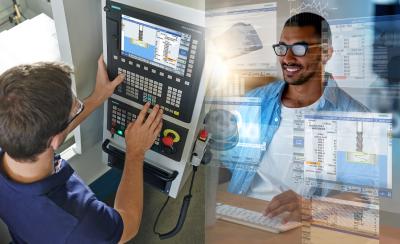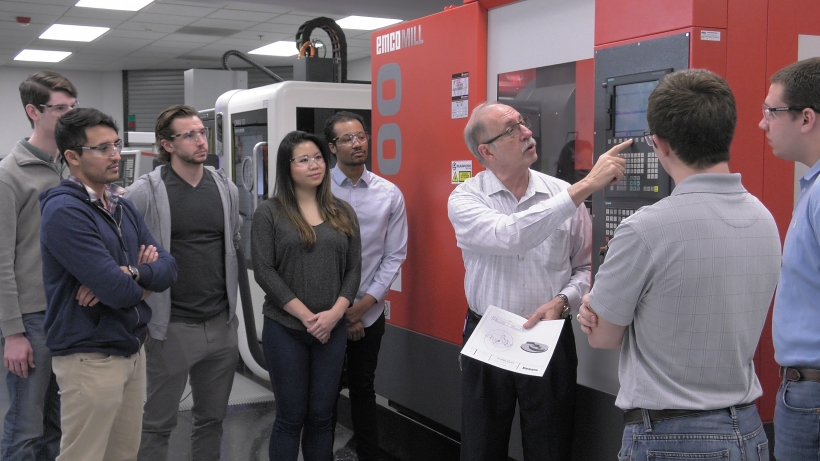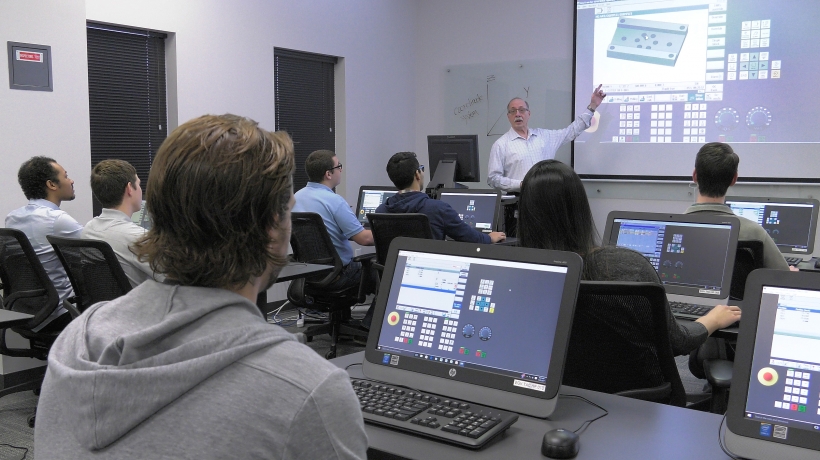
Hands-on and online learning bring growth opportunities. Programmers, operators and maintenance professionals can maximize results with a Siemens CNC to become indispensable on the shop floor and in their careers. Owners can maximize ROI in all areas of investment: machines, people and operations.
CNC professionals from around the world are taking advantage of Siemens free training paths: hands-on and online. And the reason is clear. As an operator, you can gain the skills to maximize the output of your machine, increase your value to the business and further your career. As an owner, you can skill up your staff to generate more shop floor revenue. The means to control your future is in your hands.
"At the Siemens Technical Application Center, our goal is the education of CNC operators, programmers and maintenance professionals," said Randy Pearson, technical application center manager for Siemens. "We aim to enhance and expand the knowledge and capacity of our students on Sinumerik controls. If you want to become a power user, we have the courses for you. We also provide essential training to machine tool builders, importers and dealers."
 Hands-on learning sessions at a Siemens training center — such as this one in Elk Grove Village, Illinois — provide instructor-led experience you can apply to power up a machine tool career.
Hands-on learning sessions at a Siemens training center — such as this one in Elk Grove Village, Illinois — provide instructor-led experience you can apply to power up a machine tool career.
Through a team of knowledgeable Siemens instructors, you can gain first-hand experience working on the types of machines you will encounter in your own shop. A comprehensive schedule guides you on the journey from introductory classes through advanced 5-axis programming.
"Every month we provide level one courses on milling and turning," Pearson said. "Level two courses explore advanced G-code programming, while level three focuses on multiaxis programming." Classes are taught by Siemens machining experts, bringing a wealth of real-world experiences to bear, using several different teaching methods:
- SINUTRAIN PC-based classroom sessions
- Simulator-based classroom training
- Hands-on machining using industry leading brands
In addition, service and maintenance classes are available to teach personnel how to perform PLC and drive diagnostics, check the topology of the system, commission and troubleshoot the system.
Getting to a Siemens training center may not always be possible for you. But you still have plenty of options. Live, online courses are presented monthly, which include insightful question and answer sessions. Courses are archived and available on-demand, so you can access them anywhere, anytime. Our ever-growing CNC online learning resources are updated with new and fresh courses often. Plus, for larger groups, custom online training sessions are available.
"Our online campus, featuring dozens of technical webinars, is located at usa.siemens.com/cnc4you," said Chris Pollack, virtual technical application center manager for Siemens. "All of the topics that are covered in our hands-on classroom courses — such as variable-based programming, logic-based programming, and multi-axis milling and turning — are covered online as well."
"We have a strategy for how we want people and manufacturing to excel," Pollack said. "You may begin with a five-minute how-to video as an introduction. You will then be motivated to immerse yourself in a webinar or two and really start digging into a topic. You can follow that up by enrolling in a self-paced learning module or an instructor-led class to start engaging hands-on with the technology at a high level."
 Online or in the classroom, sessions using Sinutrain software provide the knowledge you need to propel your career forward and turn your shop floor into a powerhouse.
Online or in the classroom, sessions using Sinutrain software provide the knowledge you need to propel your career forward and turn your shop floor into a powerhouse.
The curriculum not only provides you with hands-on experience using actual Siemens CNCs, but it focuses on many of the trends that are shaping today's machining industry.
Courses are separated into four main categories: milling, turning, general operations and maintenance/service. These categories provide everything programmers, operators and maintenance staff need to advance their careers, and everything a shop owner needs to turn their shop into a competitive powerhouse.
Machine shops are finding that today's digital-savvy workforce more readily interacts with controls that speak their digital language. The Sinumerik CNC platform is based on a modern, app-like interface that is easily engaged shop-wide, from 3-axis all the way to full 5-axis machining.
Machine shops are addressing fierce competitive time and cost pressures. Training staff on mixed-technology machines that do the work of two or more machines simplifies scheduling, reduces setups and accelerates production. Sinumerik CNC simplifies the integration of automated processes, such as robotics, that allow you to do much more, in much less time.
Contact Details
Related Glossary Terms
- G-code programming
G-code programming
Programs written to operate NC machines with control systems that comply with the ANSI/EIA RS-274-D-1980 Standard. A program consists of a series of data blocks, each of which is treated as a unit by the controller and contains enough information for a complete command to be carried out by the machine.
- computer numerical control ( CNC)
computer numerical control ( CNC)
Microprocessor-based controller dedicated to a machine tool that permits the creation or modification of parts. Programmed numerical control activates the machine’s servos and spindle drives and controls the various machining operations. See DNC, direct numerical control; NC, numerical control.
- gang cutting ( milling)
gang cutting ( milling)
Machining with several cutters mounted on a single arbor, generally for simultaneous cutting.
- milling
milling
Machining operation in which metal or other material is removed by applying power to a rotating cutter. In vertical milling, the cutting tool is mounted vertically on the spindle. In horizontal milling, the cutting tool is mounted horizontally, either directly on the spindle or on an arbor. Horizontal milling is further broken down into conventional milling, where the cutter rotates opposite the direction of feed, or “up” into the workpiece; and climb milling, where the cutter rotates in the direction of feed, or “down” into the workpiece. Milling operations include plane or surface milling, endmilling, facemilling, angle milling, form milling and profiling.
- robotics
robotics
Discipline involving self-actuating and self-operating devices. Robots frequently imitate human capabilities, including the ability to manipulate physical objects while evaluating and reacting appropriately to various stimuli. See industrial robot; robot.
- shaping
shaping
Using a shaper primarily to produce flat surfaces in horizontal, vertical or angular planes. It can also include the machining of curved surfaces, helixes, serrations and special work involving odd and irregular shapes. Often used for prototype or short-run manufacturing to eliminate the need for expensive special tooling or processes.
- turning
turning
Workpiece is held in a chuck, mounted on a face plate or secured between centers and rotated while a cutting tool, normally a single-point tool, is fed into it along its periphery or across its end or face. Takes the form of straight turning (cutting along the periphery of the workpiece); taper turning (creating a taper); step turning (turning different-size diameters on the same work); chamfering (beveling an edge or shoulder); facing (cutting on an end); turning threads (usually external but can be internal); roughing (high-volume metal removal); and finishing (final light cuts). Performed on lathes, turning centers, chucking machines, automatic screw machines and similar machines.

